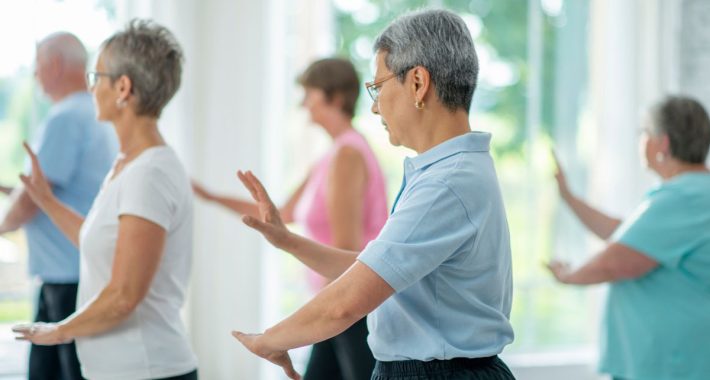
Overview
Join the UC Irvine Susan Samueli Integrative Health Institute and Shin Lin, PhD, for an in-person and beginner-friendly Tai Chi class. This 6-week series will provide participants with an in-depth teaching of Tai Chi focused on strengthening muscles, tendons and bones; improving cardiovascular, respiratory and immune functions; enhancing mood, sleep, memory, cognition and brain connectivity; and relieving stress, pain and inflammation.
This class is open to all, whether you are just beginning an exercise program, are restricted by a medical condition, or are in peak physical health. This low-impact exercise is often combined with Qigong to increase vital energy and help the body heal itself. Tai Chi has been shown to improve strength, range of motion, and overall physical function. Research indicates it may also have beneficial effects for some clinical conditions.
How can this help me?
Unlike the traditional teaching of a long series of different Tai Chi and Qigong movements, Dr. Shin Lin’s classes emphasize those which have been demonstrated in studies in Dr. Lin’s and his colleagues’ laboratories to be the most effective ones for strengthening muscles, tendons and bones; improving cardiovascular, respiratory and immune functions; enhancing mood, sleep, memory, cognition and brain connectivity; and relieving stress, pain and inflammation.
For a beginner class, visit this class page.
To participate in this course you will be required to review and sign our Acknowledgment of Risk. Please click the button below to review, sign, and submit the waiver prior to class.
Location
Susan Samueli Integrative Health Institute: 856 Health Sciences Road, Irvine, CA 92617.
Class will be held outside of the Susan & Henry Samueli College of Health Sciences building, next to the auditorium located nearby the Susan Samueli Integrative Health Institute first floor entrance.
Note
By registering for the intermediate class, you have gained FREE access to The Art and Science of Tai Chi for Beginners classes. The beginner classes are held immediately before the intermediate classes on the same days from 4:30–5:30 p.m. You are invited to come before your intermediate sessions to attend the beginners classes.
References
Abbott R, Lavretsky H. Tai Chi and Qigong for the treatment and prevention of mental disorders. Psychiatr Clin North Am. 2013;36(1):109-119. doi:10.1016/j.psc.2013.01.011 https://www.ncbi.nlm.nih.gov/pmc/articles/PMC3917559/
Irwin MR. Olmstead R, Oxman MN. Augmenting immune responses to varicella zoster (shingles) virus in older adults: a randomized, controlled trial of Tai Chi. J. Am. Geriatris Soc. 2007; 55 (4):511-517. https://doi.org/10.1111/j.1532-5415.2007.01109.x
Irwin MR, Olmstead. 2012. Mitigating cellular inflammation in older adults: a randomized controlled trial of Tai Chi Chi. Am. J. Geriatric Psych.; 20 (9): 764-772. https://doi.org/10.1097/JGP.0b013e3182330fd3
Jahnke R, Larkey L, Rogers C, Etnier J, Lin F. A comprehensive review of health benefits of qigong and tai chi. Am J Health Promot. 2010;24(6):e1-e25. doi:10.4278/ajhp.081013-LIT-248 https://www.ncbi.nlm.nih.gov/pmc/articles/PMC3085832/
Song QH, Zhang QH, Xu RM, Ma M, Zhao XP, Shen GQ, Gao YH, Wang Y. Effect of Tai Chi exercise on lower limb muscle strength, bone density and balance function of elderly women. Int. J. Clin. Exp. Med. 2014; 7 (6): 1569-1576. https://www.ncbi.nlm.nih.gov/pmc/articles/PMC4100967/
Wei GX, Dong HM, Yang Z, Luo J, Zuo XN. Tai Chi Chuan optimizes the functional organization of the intrinsic human brain architecture in older adults. Front. Aging Neurosci. 2014. https://doi.org/10.3389/fnagi.2014.00074
Yang, G. Y., Hunter, J., Bu, F. L., Hao, W. L., Zhang, H., Wayne, P. M., & Liu, J. P. (2022). Determining the safety and effectiveness of Tai Chi: a critical overview of 210 systematic reviews of controlled clinical trials. Systematic reviews, 11(1), 260. https://doi.org/10.1186/s13643-022-02100-5 Yeh GY, Wang C, Wayne PM, Phillips R. Tai Chi exercise for patients with cardiovascular conditions and risk factors: a systematic review. J. Cardiopulm. Rehabil. Prev.2010; 29 (3): 152-160. https://dx.doi.org/10.1097%2FHCR.0b013e3181a33379

